Domino's Pizza Ethical Crisis: An In-depth ACCG100 Case Study
VerifiedAdded on 2023/06/07
|6
|1545
|192
Case Study
AI Summary
This case study examines the ethical crisis faced by Domino's Pizza in 2009 when employees posted a video of unsanitary practices online. The study details the company's background, the ethical dilemma it faced, and the impact on stakeholders, including customers and employees. It evaluates Domino's response, particularly the 'Pizza Turnaround' campaign, and discusses the importance of business ethics in maintaining brand image and customer loyalty. The study also differentiates between ethics and morals, highlighting their relevance in guiding business conduct. The assignment concludes with a reflection on how the case study and related lectures have shaped the understanding of business ethics. Desklib provides access to similar case studies and resources for students.
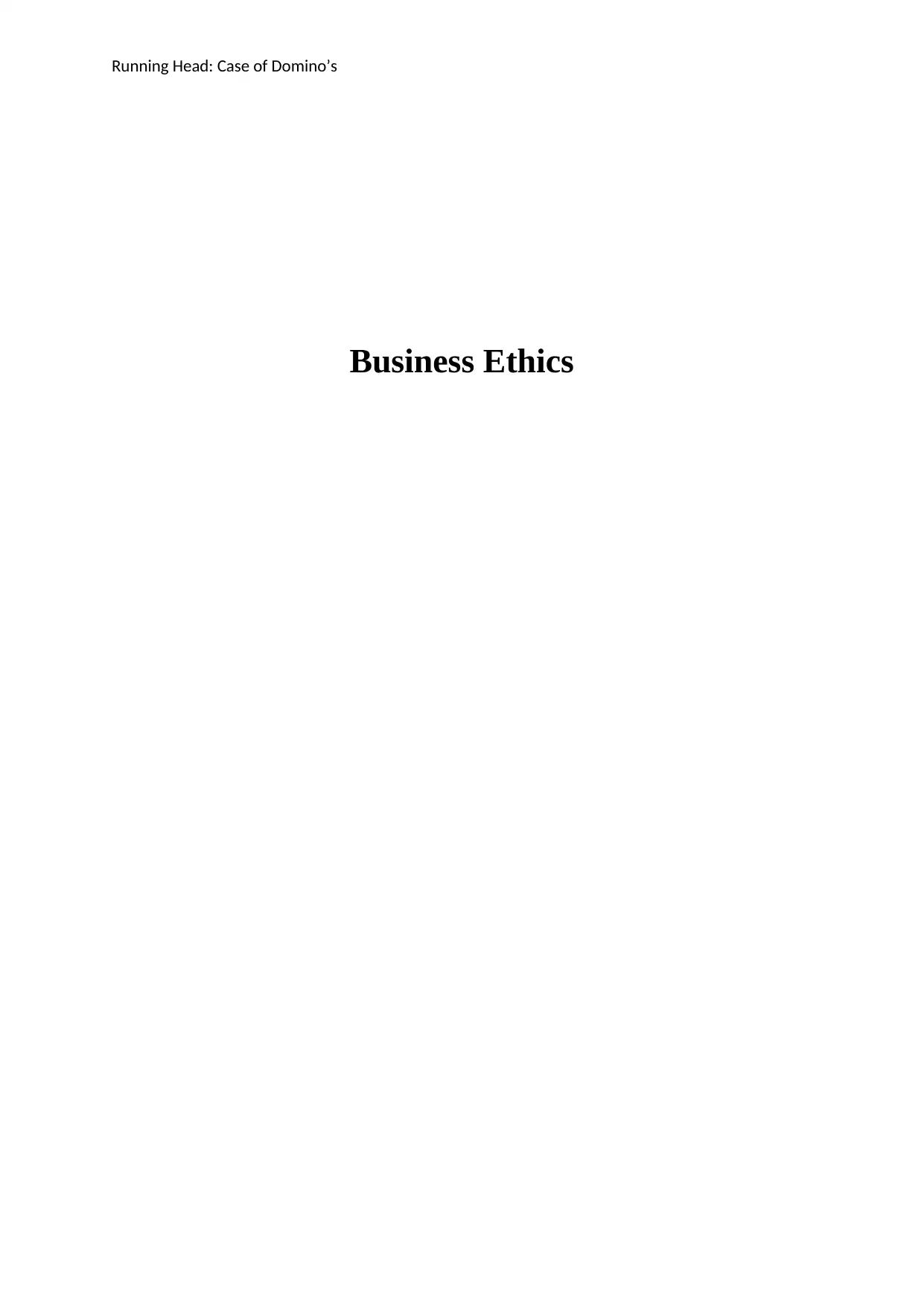
Running Head: Case of Domino’s
Business Ethics
Business Ethics
Paraphrase This Document
Need a fresh take? Get an instant paraphrase of this document with our AI Paraphraser
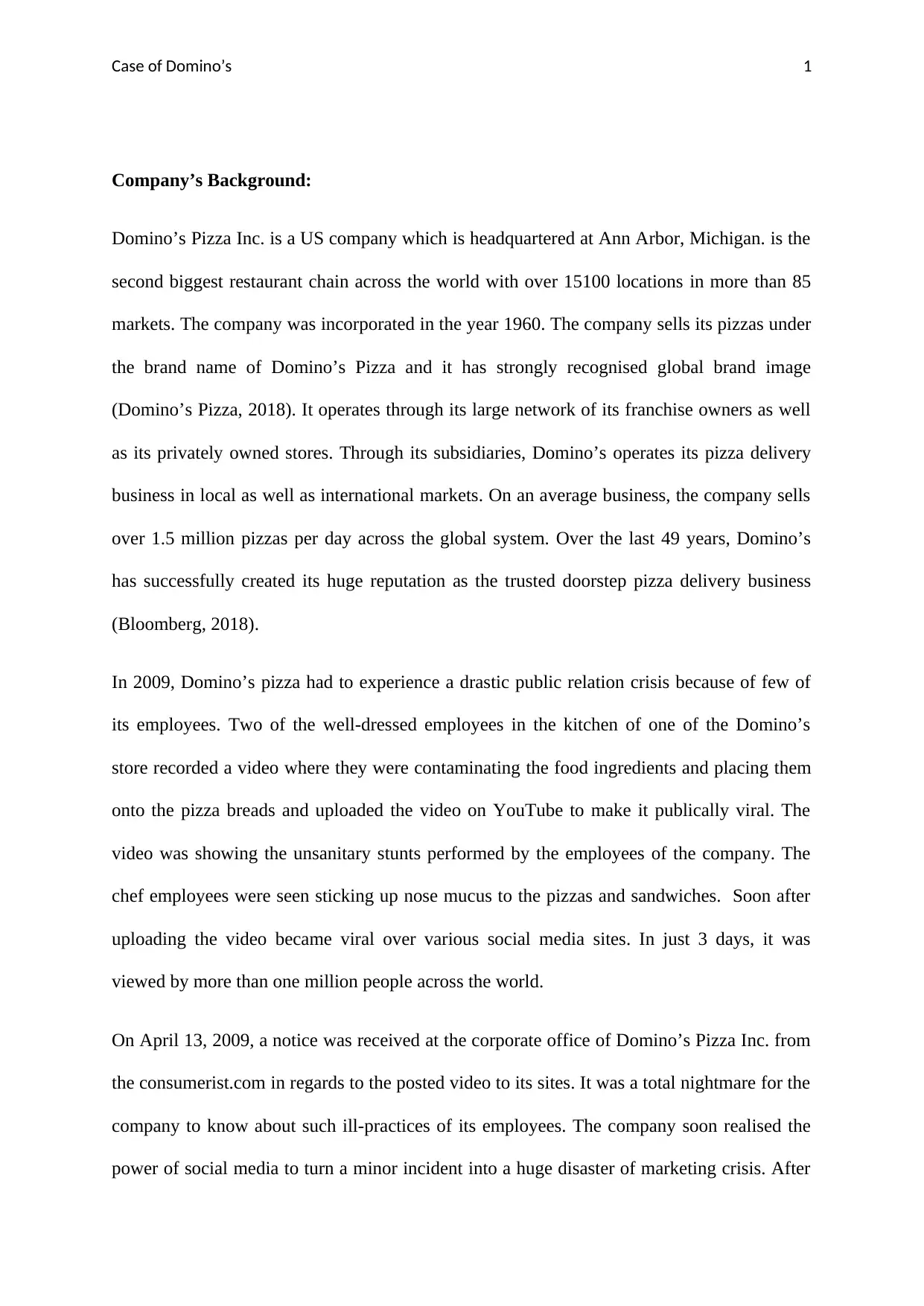
Case of Domino’s 1
Company’s Background:
Domino’s Pizza Inc. is a US company which is headquartered at Ann Arbor, Michigan. is the
second biggest restaurant chain across the world with over 15100 locations in more than 85
markets. The company was incorporated in the year 1960. The company sells its pizzas under
the brand name of Domino’s Pizza and it has strongly recognised global brand image
(Domino’s Pizza, 2018). It operates through its large network of its franchise owners as well
as its privately owned stores. Through its subsidiaries, Domino’s operates its pizza delivery
business in local as well as international markets. On an average business, the company sells
over 1.5 million pizzas per day across the global system. Over the last 49 years, Domino’s
has successfully created its huge reputation as the trusted doorstep pizza delivery business
(Bloomberg, 2018).
In 2009, Domino’s pizza had to experience a drastic public relation crisis because of few of
its employees. Two of the well-dressed employees in the kitchen of one of the Domino’s
store recorded a video where they were contaminating the food ingredients and placing them
onto the pizza breads and uploaded the video on YouTube to make it publically viral. The
video was showing the unsanitary stunts performed by the employees of the company. The
chef employees were seen sticking up nose mucus to the pizzas and sandwiches. Soon after
uploading the video became viral over various social media sites. In just 3 days, it was
viewed by more than one million people across the world.
On April 13, 2009, a notice was received at the corporate office of Domino’s Pizza Inc. from
the consumerist.com in regards to the posted video to its sites. It was a total nightmare for the
company to know about such ill-practices of its employees. The company soon realised the
power of social media to turn a minor incident into a huge disaster of marketing crisis. After
Company’s Background:
Domino’s Pizza Inc. is a US company which is headquartered at Ann Arbor, Michigan. is the
second biggest restaurant chain across the world with over 15100 locations in more than 85
markets. The company was incorporated in the year 1960. The company sells its pizzas under
the brand name of Domino’s Pizza and it has strongly recognised global brand image
(Domino’s Pizza, 2018). It operates through its large network of its franchise owners as well
as its privately owned stores. Through its subsidiaries, Domino’s operates its pizza delivery
business in local as well as international markets. On an average business, the company sells
over 1.5 million pizzas per day across the global system. Over the last 49 years, Domino’s
has successfully created its huge reputation as the trusted doorstep pizza delivery business
(Bloomberg, 2018).
In 2009, Domino’s pizza had to experience a drastic public relation crisis because of few of
its employees. Two of the well-dressed employees in the kitchen of one of the Domino’s
store recorded a video where they were contaminating the food ingredients and placing them
onto the pizza breads and uploaded the video on YouTube to make it publically viral. The
video was showing the unsanitary stunts performed by the employees of the company. The
chef employees were seen sticking up nose mucus to the pizzas and sandwiches. Soon after
uploading the video became viral over various social media sites. In just 3 days, it was
viewed by more than one million people across the world.
On April 13, 2009, a notice was received at the corporate office of Domino’s Pizza Inc. from
the consumerist.com in regards to the posted video to its sites. It was a total nightmare for the
company to know about such ill-practices of its employees. The company soon realised the
power of social media to turn a minor incident into a huge disaster of marketing crisis. After
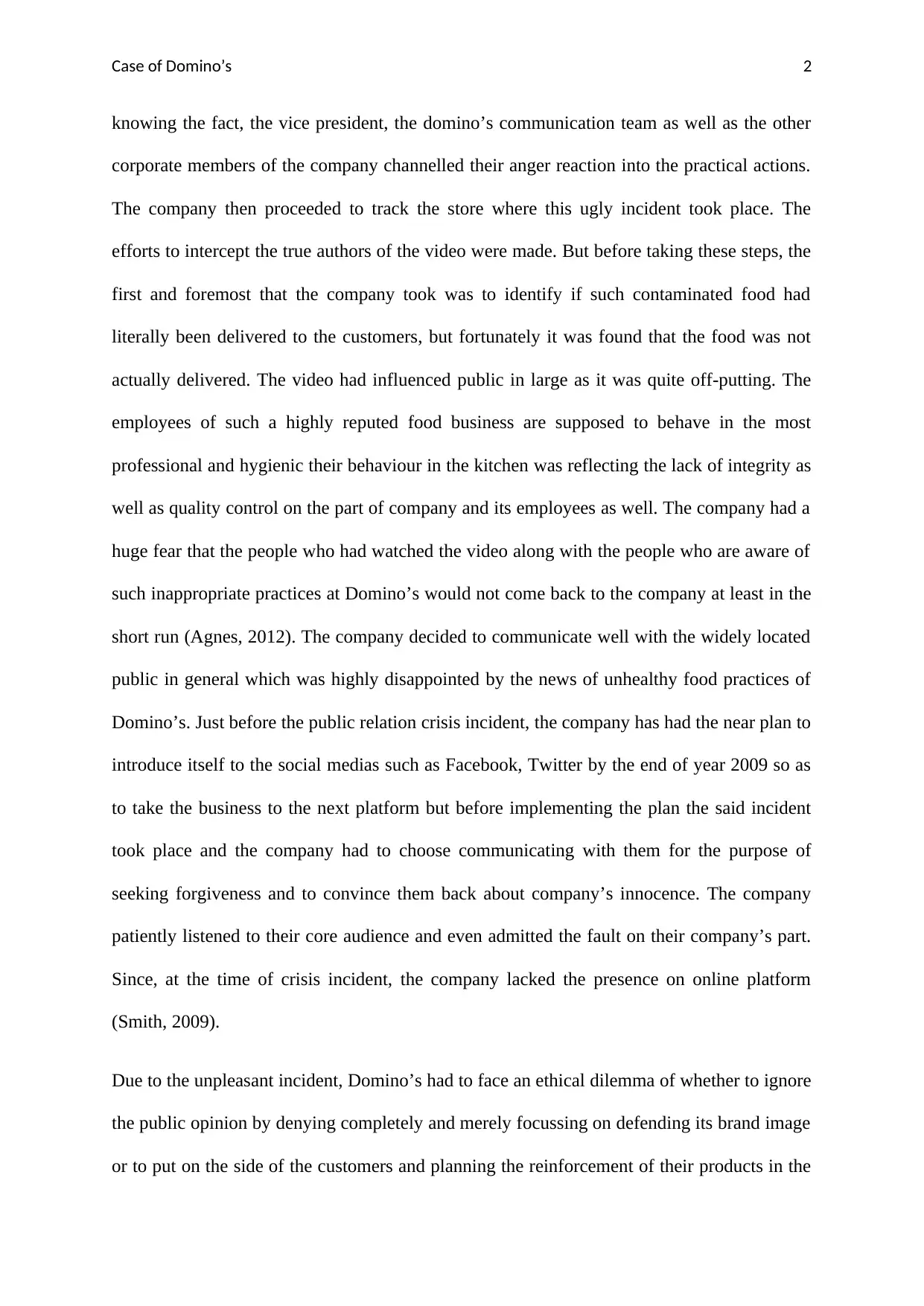
Case of Domino’s 2
knowing the fact, the vice president, the domino’s communication team as well as the other
corporate members of the company channelled their anger reaction into the practical actions.
The company then proceeded to track the store where this ugly incident took place. The
efforts to intercept the true authors of the video were made. But before taking these steps, the
first and foremost that the company took was to identify if such contaminated food had
literally been delivered to the customers, but fortunately it was found that the food was not
actually delivered. The video had influenced public in large as it was quite off-putting. The
employees of such a highly reputed food business are supposed to behave in the most
professional and hygienic their behaviour in the kitchen was reflecting the lack of integrity as
well as quality control on the part of company and its employees as well. The company had a
huge fear that the people who had watched the video along with the people who are aware of
such inappropriate practices at Domino’s would not come back to the company at least in the
short run (Agnes, 2012). The company decided to communicate well with the widely located
public in general which was highly disappointed by the news of unhealthy food practices of
Domino’s. Just before the public relation crisis incident, the company has had the near plan to
introduce itself to the social medias such as Facebook, Twitter by the end of year 2009 so as
to take the business to the next platform but before implementing the plan the said incident
took place and the company had to choose communicating with them for the purpose of
seeking forgiveness and to convince them back about company’s innocence. The company
patiently listened to their core audience and even admitted the fault on their company’s part.
Since, at the time of crisis incident, the company lacked the presence on online platform
(Smith, 2009).
Due to the unpleasant incident, Domino’s had to face an ethical dilemma of whether to ignore
the public opinion by denying completely and merely focussing on defending its brand image
or to put on the side of the customers and planning the reinforcement of their products in the
knowing the fact, the vice president, the domino’s communication team as well as the other
corporate members of the company channelled their anger reaction into the practical actions.
The company then proceeded to track the store where this ugly incident took place. The
efforts to intercept the true authors of the video were made. But before taking these steps, the
first and foremost that the company took was to identify if such contaminated food had
literally been delivered to the customers, but fortunately it was found that the food was not
actually delivered. The video had influenced public in large as it was quite off-putting. The
employees of such a highly reputed food business are supposed to behave in the most
professional and hygienic their behaviour in the kitchen was reflecting the lack of integrity as
well as quality control on the part of company and its employees as well. The company had a
huge fear that the people who had watched the video along with the people who are aware of
such inappropriate practices at Domino’s would not come back to the company at least in the
short run (Agnes, 2012). The company decided to communicate well with the widely located
public in general which was highly disappointed by the news of unhealthy food practices of
Domino’s. Just before the public relation crisis incident, the company has had the near plan to
introduce itself to the social medias such as Facebook, Twitter by the end of year 2009 so as
to take the business to the next platform but before implementing the plan the said incident
took place and the company had to choose communicating with them for the purpose of
seeking forgiveness and to convince them back about company’s innocence. The company
patiently listened to their core audience and even admitted the fault on their company’s part.
Since, at the time of crisis incident, the company lacked the presence on online platform
(Smith, 2009).
Due to the unpleasant incident, Domino’s had to face an ethical dilemma of whether to ignore
the public opinion by denying completely and merely focussing on defending its brand image
or to put on the side of the customers and planning the reinforcement of their products in the
⊘ This is a preview!⊘
Do you want full access?
Subscribe today to unlock all pages.

Trusted by 1+ million students worldwide
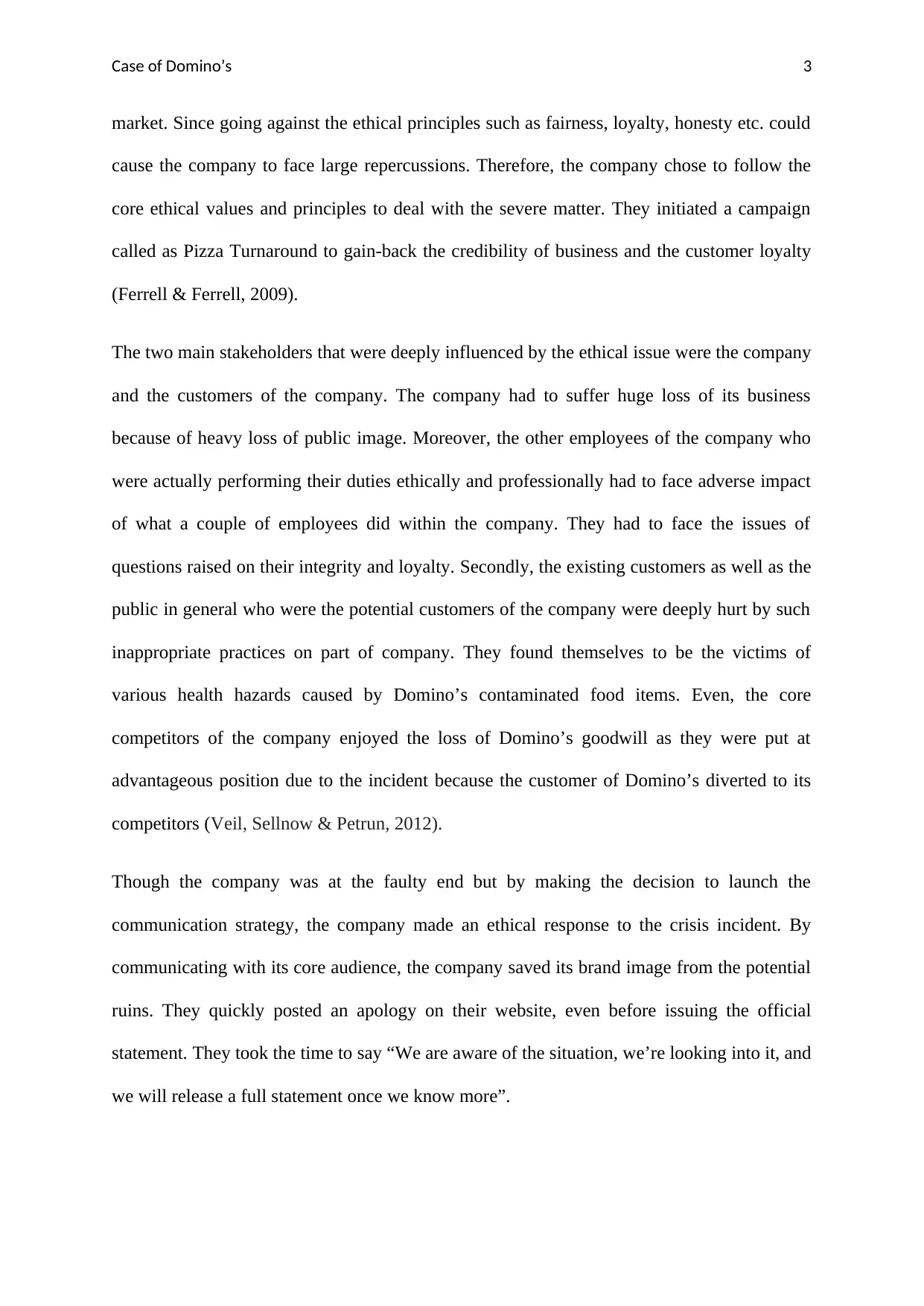
Case of Domino’s 3
market. Since going against the ethical principles such as fairness, loyalty, honesty etc. could
cause the company to face large repercussions. Therefore, the company chose to follow the
core ethical values and principles to deal with the severe matter. They initiated a campaign
called as Pizza Turnaround to gain-back the credibility of business and the customer loyalty
(Ferrell & Ferrell, 2009).
The two main stakeholders that were deeply influenced by the ethical issue were the company
and the customers of the company. The company had to suffer huge loss of its business
because of heavy loss of public image. Moreover, the other employees of the company who
were actually performing their duties ethically and professionally had to face adverse impact
of what a couple of employees did within the company. They had to face the issues of
questions raised on their integrity and loyalty. Secondly, the existing customers as well as the
public in general who were the potential customers of the company were deeply hurt by such
inappropriate practices on part of company. They found themselves to be the victims of
various health hazards caused by Domino’s contaminated food items. Even, the core
competitors of the company enjoyed the loss of Domino’s goodwill as they were put at
advantageous position due to the incident because the customer of Domino’s diverted to its
competitors (Veil, Sellnow & Petrun, 2012).
Though the company was at the faulty end but by making the decision to launch the
communication strategy, the company made an ethical response to the crisis incident. By
communicating with its core audience, the company saved its brand image from the potential
ruins. They quickly posted an apology on their website, even before issuing the official
statement. They took the time to say “We are aware of the situation, we’re looking into it, and
we will release a full statement once we know more”.
market. Since going against the ethical principles such as fairness, loyalty, honesty etc. could
cause the company to face large repercussions. Therefore, the company chose to follow the
core ethical values and principles to deal with the severe matter. They initiated a campaign
called as Pizza Turnaround to gain-back the credibility of business and the customer loyalty
(Ferrell & Ferrell, 2009).
The two main stakeholders that were deeply influenced by the ethical issue were the company
and the customers of the company. The company had to suffer huge loss of its business
because of heavy loss of public image. Moreover, the other employees of the company who
were actually performing their duties ethically and professionally had to face adverse impact
of what a couple of employees did within the company. They had to face the issues of
questions raised on their integrity and loyalty. Secondly, the existing customers as well as the
public in general who were the potential customers of the company were deeply hurt by such
inappropriate practices on part of company. They found themselves to be the victims of
various health hazards caused by Domino’s contaminated food items. Even, the core
competitors of the company enjoyed the loss of Domino’s goodwill as they were put at
advantageous position due to the incident because the customer of Domino’s diverted to its
competitors (Veil, Sellnow & Petrun, 2012).
Though the company was at the faulty end but by making the decision to launch the
communication strategy, the company made an ethical response to the crisis incident. By
communicating with its core audience, the company saved its brand image from the potential
ruins. They quickly posted an apology on their website, even before issuing the official
statement. They took the time to say “We are aware of the situation, we’re looking into it, and
we will release a full statement once we know more”.
Paraphrase This Document
Need a fresh take? Get an instant paraphrase of this document with our AI Paraphraser
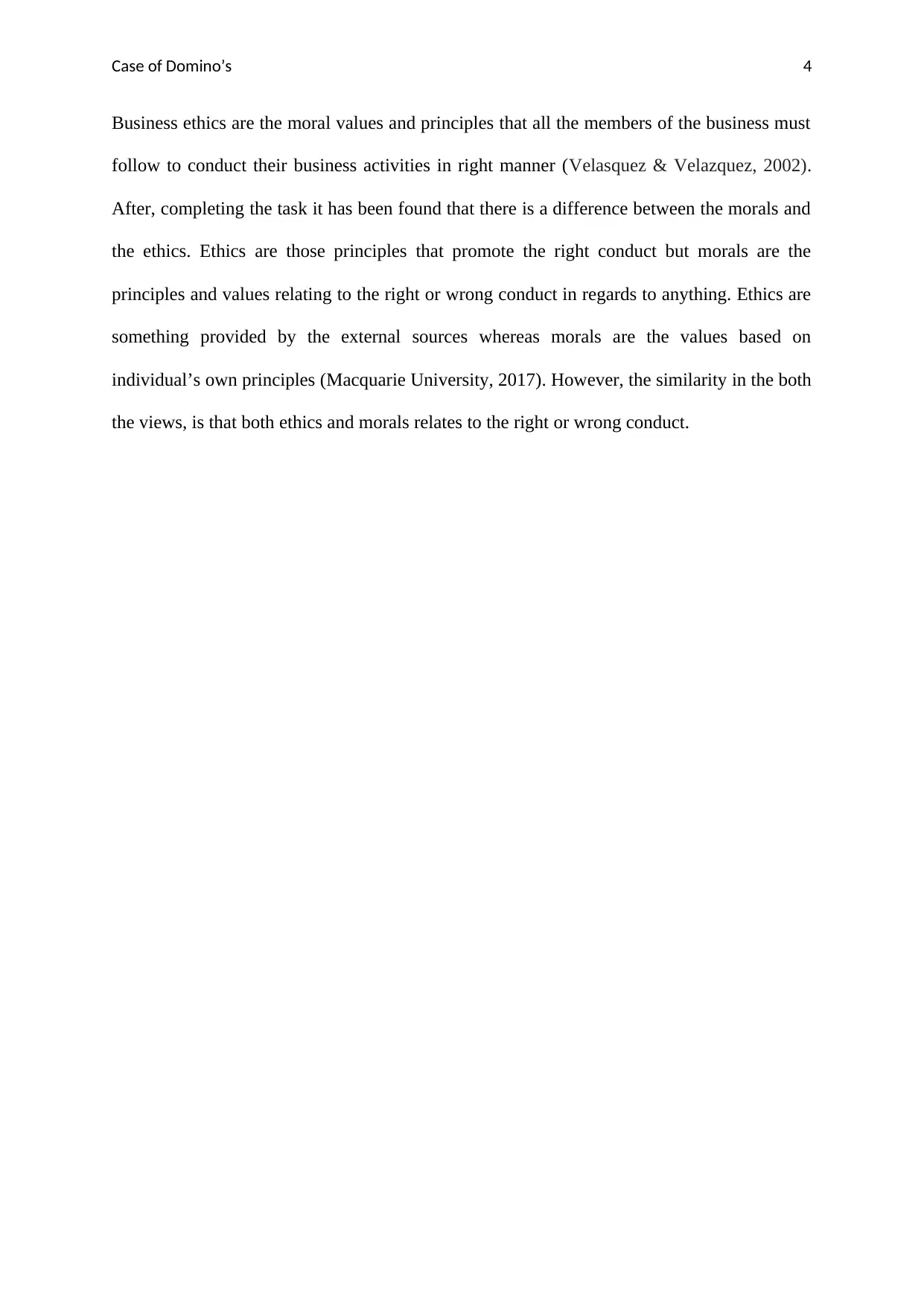
Case of Domino’s 4
Business ethics are the moral values and principles that all the members of the business must
follow to conduct their business activities in right manner (Velasquez & Velazquez, 2002).
After, completing the task it has been found that there is a difference between the morals and
the ethics. Ethics are those principles that promote the right conduct but morals are the
principles and values relating to the right or wrong conduct in regards to anything. Ethics are
something provided by the external sources whereas morals are the values based on
individual’s own principles (Macquarie University, 2017). However, the similarity in the both
the views, is that both ethics and morals relates to the right or wrong conduct.
Business ethics are the moral values and principles that all the members of the business must
follow to conduct their business activities in right manner (Velasquez & Velazquez, 2002).
After, completing the task it has been found that there is a difference between the morals and
the ethics. Ethics are those principles that promote the right conduct but morals are the
principles and values relating to the right or wrong conduct in regards to anything. Ethics are
something provided by the external sources whereas morals are the values based on
individual’s own principles (Macquarie University, 2017). However, the similarity in the both
the views, is that both ethics and morals relates to the right or wrong conduct.
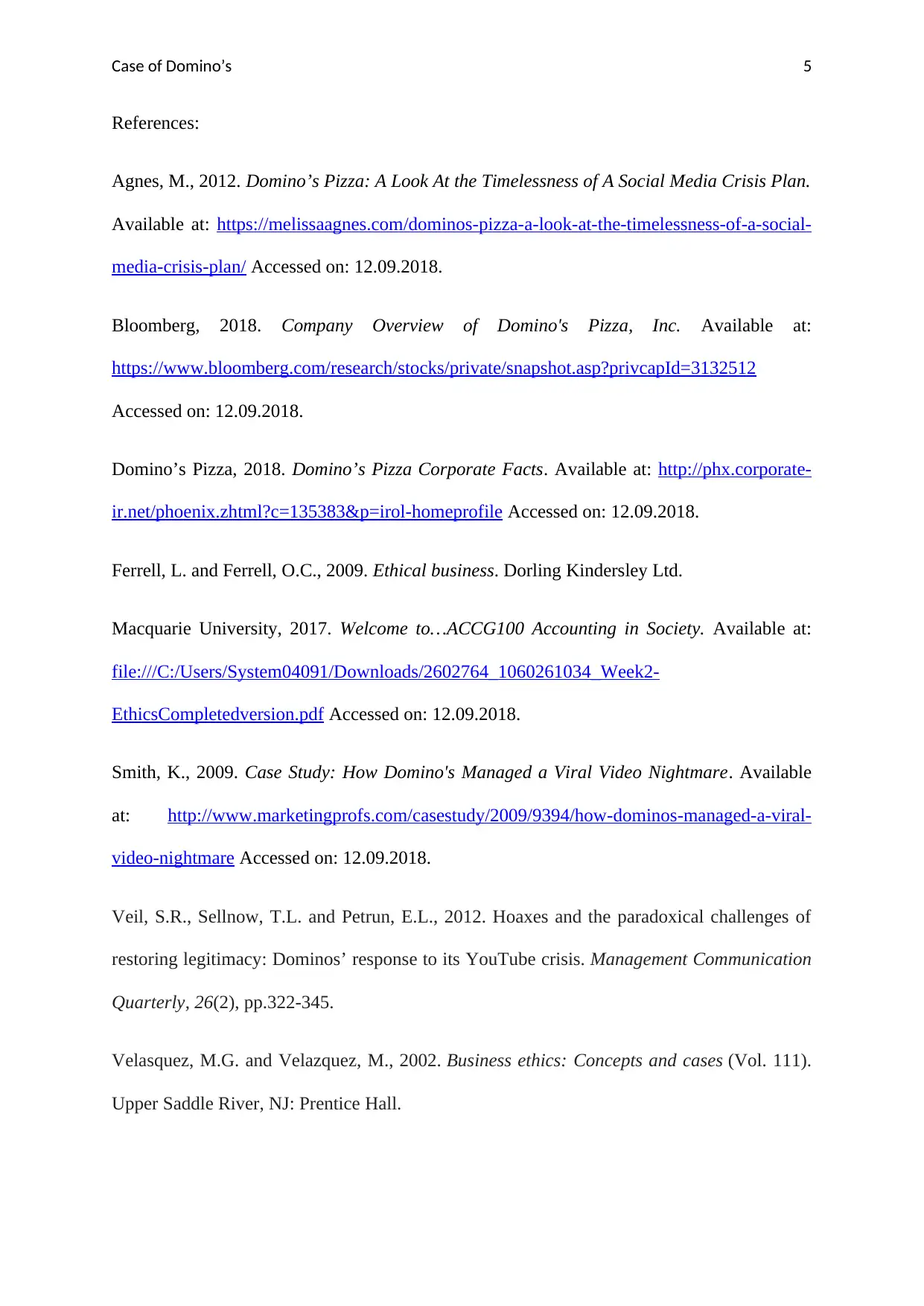
Case of Domino’s 5
References:
Agnes, M., 2012. Domino’s Pizza: A Look At the Timelessness of A Social Media Crisis Plan.
Available at: https://melissaagnes.com/dominos-pizza-a-look-at-the-timelessness-of-a-social-
media-crisis-plan/ Accessed on: 12.09.2018.
Bloomberg, 2018. Company Overview of Domino's Pizza, Inc. Available at:
https://www.bloomberg.com/research/stocks/private/snapshot.asp?privcapId=3132512
Accessed on: 12.09.2018.
Domino’s Pizza, 2018. Domino’s Pizza Corporate Facts. Available at: http://phx.corporate-
ir.net/phoenix.zhtml?c=135383&p=irol-homeprofile Accessed on: 12.09.2018.
Ferrell, L. and Ferrell, O.C., 2009. Ethical business. Dorling Kindersley Ltd.
Macquarie University, 2017. Welcome to…ACCG100 Accounting in Society. Available at:
file:///C:/Users/System04091/Downloads/2602764_1060261034_Week2-
EthicsCompletedversion.pdf Accessed on: 12.09.2018.
Smith, K., 2009. Case Study: How Domino's Managed a Viral Video Nightmare. Available
at: http://www.marketingprofs.com/casestudy/2009/9394/how-dominos-managed-a-viral-
video-nightmare Accessed on: 12.09.2018.
Veil, S.R., Sellnow, T.L. and Petrun, E.L., 2012. Hoaxes and the paradoxical challenges of
restoring legitimacy: Dominos’ response to its YouTube crisis. Management Communication
Quarterly, 26(2), pp.322-345.
Velasquez, M.G. and Velazquez, M., 2002. Business ethics: Concepts and cases (Vol. 111).
Upper Saddle River, NJ: Prentice Hall.
References:
Agnes, M., 2012. Domino’s Pizza: A Look At the Timelessness of A Social Media Crisis Plan.
Available at: https://melissaagnes.com/dominos-pizza-a-look-at-the-timelessness-of-a-social-
media-crisis-plan/ Accessed on: 12.09.2018.
Bloomberg, 2018. Company Overview of Domino's Pizza, Inc. Available at:
https://www.bloomberg.com/research/stocks/private/snapshot.asp?privcapId=3132512
Accessed on: 12.09.2018.
Domino’s Pizza, 2018. Domino’s Pizza Corporate Facts. Available at: http://phx.corporate-
ir.net/phoenix.zhtml?c=135383&p=irol-homeprofile Accessed on: 12.09.2018.
Ferrell, L. and Ferrell, O.C., 2009. Ethical business. Dorling Kindersley Ltd.
Macquarie University, 2017. Welcome to…ACCG100 Accounting in Society. Available at:
file:///C:/Users/System04091/Downloads/2602764_1060261034_Week2-
EthicsCompletedversion.pdf Accessed on: 12.09.2018.
Smith, K., 2009. Case Study: How Domino's Managed a Viral Video Nightmare. Available
at: http://www.marketingprofs.com/casestudy/2009/9394/how-dominos-managed-a-viral-
video-nightmare Accessed on: 12.09.2018.
Veil, S.R., Sellnow, T.L. and Petrun, E.L., 2012. Hoaxes and the paradoxical challenges of
restoring legitimacy: Dominos’ response to its YouTube crisis. Management Communication
Quarterly, 26(2), pp.322-345.
Velasquez, M.G. and Velazquez, M., 2002. Business ethics: Concepts and cases (Vol. 111).
Upper Saddle River, NJ: Prentice Hall.
⊘ This is a preview!⊘
Do you want full access?
Subscribe today to unlock all pages.

Trusted by 1+ million students worldwide
1 out of 6
Related Documents
Your All-in-One AI-Powered Toolkit for Academic Success.
+13062052269
info@desklib.com
Available 24*7 on WhatsApp / Email
![[object Object]](/_next/static/media/star-bottom.7253800d.svg)
Unlock your academic potential
Copyright © 2020–2025 A2Z Services. All Rights Reserved. Developed and managed by ZUCOL.





